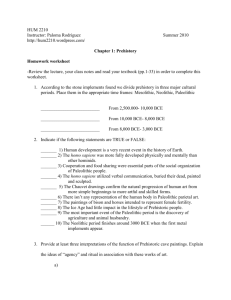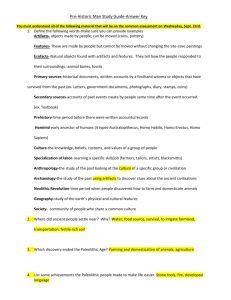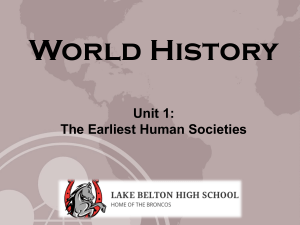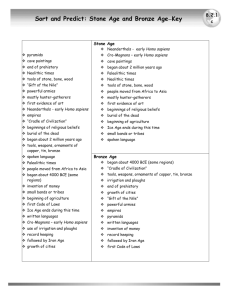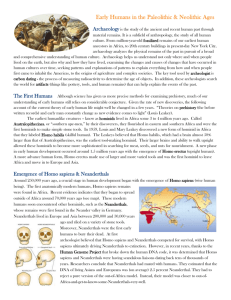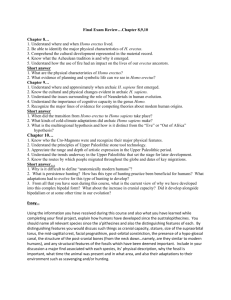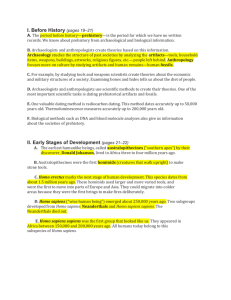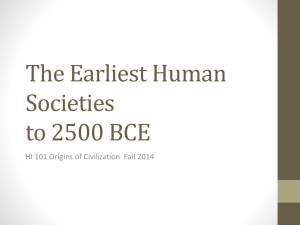File - Fudan World History
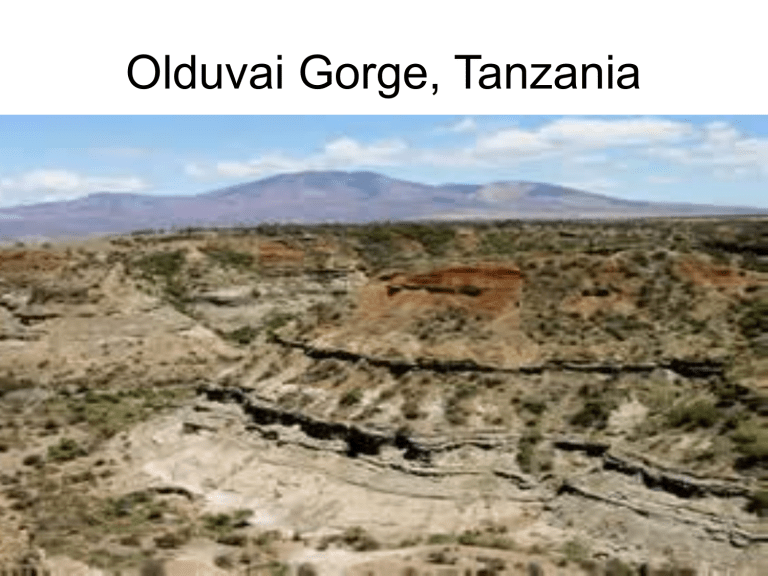
Olduvai Gorge, Tanzania
The Leaky Family Excavating
Paleolithic Age
2 million to 20,000 BCE
Lucy “Mother of Man” (Ethiopia)
(Australopithecus 3.2 million BCE)
Evolution, Human Migration, Rise of Agriculture, and Civilization
• Olduvai Gorge, Kenya
• Oldest human beings
• Lucy “Mother of Man”
• Human Migrations
• Homo Erectus
750000-600,000
• Peking/Java Man
• Homo Sapiens 200000
• Successive Waves out of
Africa
• Cro-Magnons or
Neanderthals Europe
• Inter-breeding
• Melanesians SE Asia
• Australian Aborigines
Lucy “Mother of Man” (Ethiopia)
(Australopithecus 3.2 million BCE)
Peking Man (Homo Erectus)
The “Missing Link” between
Erectus and Homo Sapiens?
Gawis Cranium in 2006 in Ethiopia
Evolutionary Progression
Flores Man (Hobbit), 2003
Homo floresiensis (3 feet tall) goes extinct 12,000 years ago
Homo Sapiens/Neanderthal
Inter-breeding
Distribution of Neanderthals
Neanderthals and Humans extinct 25,000-30,000 years ago
Tracking Human Migration
• Human Skeleton Remains
• Archeological Evidence
– Midden mounds
– Fire Pits
• Linguistic Mapping/Language Trees
• Evolutionary Progression of Language
• Genetic Mapping/DNA Mutations
• Mapping of the Human Genome
Human Skeleton Remains
Midden mounds
Pre-historic fire pits
Radio Carbon Dating Machine
Human Migration of Homo Sapiens
Migration of Humans
San/Bushmen Kalahari
World’s Oldest Culture 80,000BCE
Hunter-Gatherer Societies
• Way of life during the Paleolithic Era
• Men hunters
• Women gatherers
• Egalitarian Societies (Everyone equal)
• Everyone shares in the food they collect
• No chiefs/kings/leaders
• Old people do have more status
• Organized into extended families/clans
• Usually 25-75 people
Bantu Language Migration
Migration of the German Language
Linguistic Migration of Maya
DNA Mutations
Tracking through DNA Mutations
Mapping of the Human Genome is
Complete
Human Historical Eras
• Stone Age/Paleolithic 2,000,000-12,000
• Middle Stone Age/Meso 12,000-8000 BCE
– Domestication of Animals, Pastoralists
• New Stone Age/Neolithic 8000BCE-
• Neolithic Revolution
– Rise of Agriculture
– Domestication of Animals
– Metal Working (Copper)
• Bronze Age/Iron Age
The study of past societies through an analysis of what people have left behind.
Artifacts are those things that people left behind, they can include:
Tools and Weapons
Art and Sculpture Pottery
Jewelry
Human Remains
Ancient Buildings and Monuments
The study of human life and culture
The remains of ancient plants and animals.
By studying fossils archaeologists and anthropologists can learn about what people ate, what animals they had around, and their way of life.
Carbon dating can be used to date organic artifacts, or things that were once alive
All living things contain a radioactive isotope of Carbon called Carbon 14 which they absorb from the sun while they are alive.
Carbon 14 has a half-life of 5000 years. That means it takes 5,000 years for half of the Carbon 14 in something to break down.
If we know how much Carbon 14 something has left we can count back to how much is had to begin with to determine the age of the artifact. Is limited to things 50,000 years old or less.
Developments of Paleolithic
Age
• 12,000 BCE–humans evolved physically and mentally to the level of today
– Opposable thumbs & developed brain
• Paleolithic Achievements
– Invention of tools & weapons
– Language
– Control of fire
– Art (sculpture, jewelry, and cave paintings)
• Humans lived in small bands of huntergatherers
Rise of Agriculture
• Near simultaneous emergence
• Various regions/continents around world
• Extinction of Big Game Animals
• End of Ice Age
• Agriculture discovered by accident?
• Discovered by women
• River Valley Systems
• Large Scale Irrigation Systems
World Population Growth
Intensive agriculture caused human population to jump from
5-8 million to 60 to 70 million in
5,000 years
Early Agricultural Civilizations
(River Valley Civilizations)
• “Fertile Crescent” (Tigris-Euphrates)
– Summerians, Babylonians
– Emergence of City-States
– Evolve into Regional Empires
• Early Egyptian Civilization (Nile)
• Indian (Indus) River Valley
• Chinese (Yellow) River Valley
Agricultural (Neolithic) Revolution
• Sedentary (live in one place)
• Use animals for labor (Domestication)
– Secondary benefits (Meat, Dairy, Leather, Fuel)
• Food Surplus
• Trade
• Money, Currency, Monetized Systems
• Weights and Measures
• Numbers
• Symbols
• Writing Systems
Negatives of Agricultural Revolution
(Diamond)
• Malnutrition (monocrops)
• Starvation (drought, disease)
• Disease (parasites, animals, crowding)
• Surplus/Class Divisions
• Social Stratification
• Hunter/Gather lose land and territory
• Increased Birth Rates (female mortality)
• Decrease in leisure time
• Elite become better off, the majority worse
• Starvation, Epidemics, Warfare, & Tyranny
What is a “Civilization?”
• Economic surpluses
• Division of labor (social classes)
• Social/Political hierarchy
• Transition from family/tribal ties to state
• Large scale political units: city-states/empires
• Inter-regional trade
• Some scholars argue for a writing system
• Some scholars for a monetary system
• “Civilization” does not mean “better”
The Evolution of Writing Systems
• Physical Symbol
• Pictograph (hieroglyphics)
• Ideograph (combining pictographs)
• Writing System
• Evolution from physical symbols to abstract characters to alphabets
Pictographs
Ideographs
Sumerian Cuneiform (the first true known writing system)
Evolution of Cuneiform
(from physical symbol to abstract)
Heritage of Early Civilizations
• Revolutionary concept of writing
– Changes the way we “think”
• Inventions
– Wheel, paper, animal husbandry
• Calendars and conceptions of time
• Agriculture and Agricultural Techniques
• Large-scale social organization (cities)
• Numeric systems and Mathematical concepts
• Religious systems (mono and polytheistic)
Writing System to Legal Systems
• Mesopotamia
• First codified legal code
• Social mores
• Code of Hammurabi
• Far from the notion of judicial equality
• Warped sense of guilt/innocence
